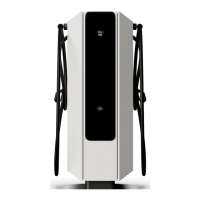
Do you have a question about the Power Electronics Standalone NB 120 and is the answer not in the manual?
| Input Voltage | 220-240V AC |
|---|---|
| Output Voltage | 12V DC |
| Output Current | 10A |
| Charging Mode | Automatic |
| Battery Type | Lead-Acid, Gel |
| Protection | Short Circuit, Reverse Polarity |
Manual's scope and content for installation, configuration, and use of the EV charger.
Intended users and prerequisites for installation and operation of the NB 120 chargers.
Identifies potentially hazardous situations and necessary precautions using warning symbols.
Important safety advice, warnings, and personnel qualifications for charger installation.
Safe handling, movement, airflow, and usage guidelines for the charging equipment.
Requirements for proper grounding to prevent electric shock.
Site installation, cleaning, and vehicle charging safety tips.
Specifies necessary PPE for repair and maintenance tasks.
Details on electrical insulated gloves and safety matting classes.
Procedures for unit reception, waste management, and network security.
Description of charger main components and features.
Details on CCS-1, CCS-2, and CHAdeMO connectors.
Information on Type 2 AC connector and step-by-step charging.
Smart Fleet Management, power balance, and door detection features.
Optional power scalability and compliance with standards.
Technical specifications for the NB 120 charger in the IEC standard.
Technical specifications for the NB 120 charger in the US standard.
Physical dimensions of the NB 120 charging station.
Center of gravity coordinates for the equipment.
Procedures for inspecting received equipment and guidelines for storage.
Guidelines for long-term storage and unpackaging the equipment.
Cautions for lifting and moving the equipment.
Steps to remove lifting tools after anchoring the equipment.
Guidelines for choosing location and soil characteristics for installation.
Requirements for the concrete foundation slab.
Recommended clearance around the equipment for safety and ventilation.
Procedures and recommendations for anchoring the charger.
Details on the forced ventilation system, including air inlets and outlets.
List of cables and elements the customer must provide.
How power and communication cables enter the equipment.
Details of the plate for cable entry and gland configuration.
General connection steps and recommended cable sizes for AC input.
Setup for Ethernet, Optical Fiber, and Wi-Fi communication.
Insulation monitoring and overcurrent/short circuit protection details.
Optional overvoltage and RCD protection features.
User interaction controls and LED status indicators.
Setup for Ethernet and Optical Fiber communication.
Optional Wi-Fi and cellular communication setup.
LOTO standards, requirements, and essential cautions.
Defines two operational states for LOTO procedures.
Step-by-step procedure for locking and tagging equipment.
Steps to reverse the LOTO procedure.
Verification steps for no voltage presence.
Safety precautions and initial startup steps for the charger.
Safety precautions and steps for safely disconnecting the charging station.
Defines two states for maintenance: Power revision and Dead revision.
Detailed list of tasks for annual maintenance.
Detailed steps for performing a power revision.
Detailed steps for performing a dead revision.